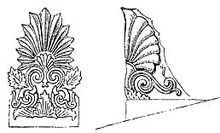Acroterion

The acroterion , also the acroter (also outdated the acrotery ; plural acroteria , acroteria , acrotere , in the field of art history also acroterion , ancient Greek τὸ ἀκρωτήριον akrotérion "top corner, tip") serves as an architectural element of the crowning of the gable ridge at the gable corners , then called Eckakroter ( acroteria angularia ).
Description, use
The acroterion is common in ancient Greek, Etruscan and Roman temple architecture and on grave stelae.

Initially a circular disc made of painted clay ( disc acroter ), for example at the Heraion in Olympia , the acroterion was developed more and more ornamentally and plastically, mostly using plant motifs such as acanthus or palmette . In addition to fully plastic acroteries in the form of vases , tripods or mythical animals such as the griffin and the sphinx , human figures - such as Niken , riding Amazons - also appear as acroterion. Examples of the decoration of ancient buildings with acroteries are the archaic Temple of Apollo in Delphi or the Temple of Asclepius in Epidaurus . In ancient times Akroteria were - as other architectural elements also - polychrome decorated, that is colored in focus . The acroterion always sits on a box that balances the sloping roof, the acroter box.
Etruscan acroters were partly decorated with figures.
The acroterion was also a common element of ornamentation in architecture in the Renaissance , Classicism and Historicism . It was by no means limited to public buildings or even immediate buildings , but was also used in profane architecture.
See also
literature
- Peter Danner: Greek Acrotere of the Archaic and Classical Times. Bretschneider, Rome 1989
- Peter Danner: Western Greek Akrotere. von Zabern, Mainz 1997, ISBN 3-8053-2002-7 .
- Angelos Delivorrias: Attic Gable Sculptures and Akrotere of the 5th Century . Wasmuth, Tübingen 1974, ISBN 3-8030-1900-1 (= Tübingen Studies on Archeology and Art History, Volume 1).
- Hildegund Gropengiesser : The vegetable acroters of classic temples . von Zabern, Mainz 1961.
- Wolfgang Herrmann: Acroterion . In: Real Lexicon on German Art History . Volume 1. Stuttgart 1934, Col. 274-282.
- August Mau : Acroterion . In: Paulys Realencyclopadie der classischen Antiquity Science (RE). Volume I, 1, Stuttgart 1893, column 1208.
Web links
- beyars.com
- Two classicist examples: Berlin, St. Elisabeth Church
- Middle acroterion. Ossobuco.de
- Corner acroterion. Ossobuco.de
Individual evidence
- ^ Marilyn Y. Goldberg: The “Eos and Cephalos” from Caere: its Subject and Date. In: American Journal of Archeology , 91, 1987, 4, pp. 605-614


